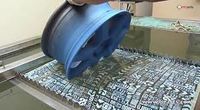Difference between revisions of "User:FleurPeters/week"
FleurPeters (talk | contribs) |
FleurPeters (talk | contribs) |
||
| Line 7: | Line 7: | ||
This printing technique is used for vehicles, cardashboards, bike helmets. Actually if you can dip the object in water and can be painted with traditional techniques the hydrographic print can be used. Before painting you have to prepair the surface with primer and paint. When you finished painting the surface is ready to be processed. A polyvinyl alcohol hydrographic film, which has been gravure-printed. On the film is the image you want to transfer. The film is carefully printed on the water’s surface. The object can be dipped in de dipping tank, the pattern or image can curve around any shape. The ink is already sticked to the object and will not fade out. After drying theres is a clear layer of coating. | This printing technique is used for vehicles, cardashboards, bike helmets. Actually if you can dip the object in water and can be painted with traditional techniques the hydrographic print can be used. Before painting you have to prepair the surface with primer and paint. When you finished painting the surface is ready to be processed. A polyvinyl alcohol hydrographic film, which has been gravure-printed. On the film is the image you want to transfer. The film is carefully printed on the water’s surface. The object can be dipped in de dipping tank, the pattern or image can curve around any shape. The ink is already sticked to the object and will not fade out. After drying theres is a clear layer of coating. | ||
| − | [[File: | + | [[File:z1.jpg|200px]] |
== Paper marbling == | == Paper marbling == | ||
Revision as of 09:24, 23 March 2017
Contents
Hydrographics
Also know as water transfer printing. This printing method can be used on 3d object and many different materials like metal, plastics, glass, ceramics and hard woods.
This printing technique is used for vehicles, cardashboards, bike helmets. Actually if you can dip the object in water and can be painted with traditional techniques the hydrographic print can be used. Before painting you have to prepair the surface with primer and paint. When you finished painting the surface is ready to be processed. A polyvinyl alcohol hydrographic film, which has been gravure-printed. On the film is the image you want to transfer. The film is carefully printed on the water’s surface. The object can be dipped in de dipping tank, the pattern or image can curve around any shape. The ink is already sticked to the object and will not fade out. After drying theres is a clear layer of coating.
Paper marbling
This marbling technique was founded in 10th century in Japan. Unfortunately, as many historical facts no one knows how old this technique is. In Japan this technique is known as Suminagashi, floating ink. They used special inks (Sumi ink). They used a shallow pan after dropping the ink in the pan the ink floats on the water’s surface. The designs where added with a fan or gently blowing. The paper is laid on the surface for a short amount of time.
This paper marbling is almost the same in west-Europe only European inks are water-based (sumi ink isn’t) so they needed an other chemical for thickening the water, 0therwise the inks will sink. This compound, was usually Tragacanth or Carrageenan (a type off moss.)
In histroy this marbled paper was used for special and important document. The marbling always has an unique pattern. The marbling always turned out different even the process was exactly the same. When the production of bookbinding took off the marbling was also used for the edges and ledgers.
Bleach printing / Discharge printing
Discharge is a lucid ink with a sort of activator. The activator (Zinc Formaldehyde Sulfoxylate), this activator cause to deactivate the dyes in the fabric. Printing the discharge ink is actually bleaching the fabric to the natural colour. Sometimes the dyes are to resistant and the bleached surfaces turn in to green, purple or royal blue. The discharged prints on resistant fabric are more muted.
Thermographic printing
This way of printing is a process that causes text or graphics to be raised from the surface. This technique is very common in packaging, business cards etc. Because it’s a tactile effect the thermography can be used for braille as well.
Thermography combines a traditional printing method with a specific type of finishing. Press sheets are printed using a regular offset press and a special type of ink that does not immediately dry. Then the sheets are getting dipped in a powdered polymer or resin. The powder sticks to the wet ink, the powder on the sheet are simply getting removed when you’re tapping on their back. Then the sheets go into a small oven thas fuses the powder with the ink (only for a few seconds). To make this step more easy you can also use a heat gun.
Dot matrix printing
A computer printing technique that uses a printhead that moves up and down, back and forth. striking an ink-soaked ribbon against the paper. This technique is like the mechanism on a typewriter. Although the letters are drawn with a dot matrix so you can choose different fonts and graphics.
Each dot is made of a small metal rod, which is driven forward by the power of a magnet, directly ro through small levers (hefbomen). Theres is a small plate ‘‘protector’’ with holes in it facing the ribbon and the paper. The plate serves as a guide for the pins, it’s made from hard plastic or an artificial jewel such as sapphire or ruby.
